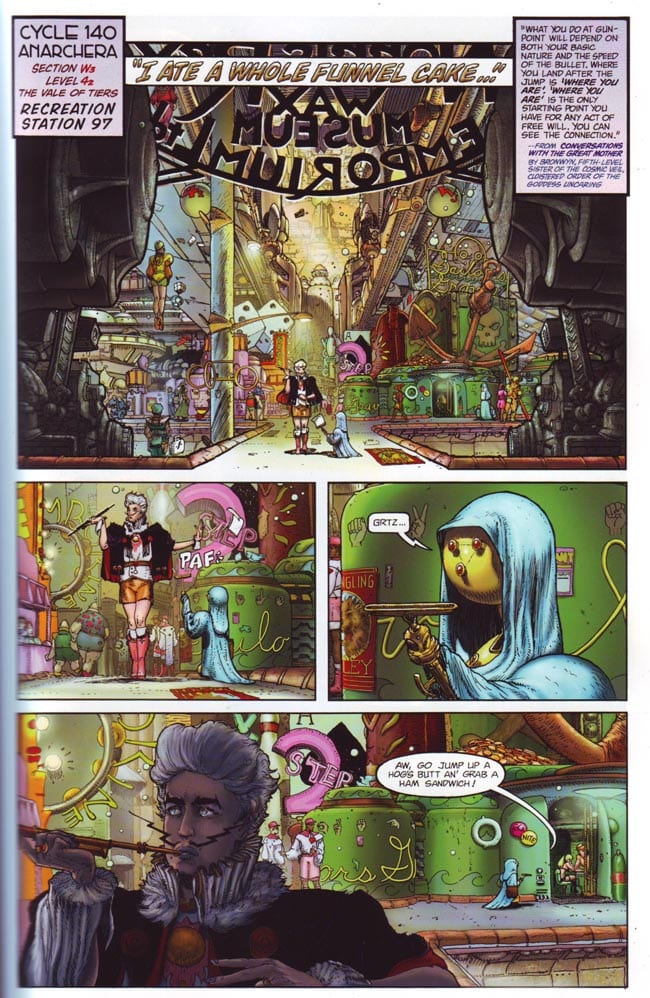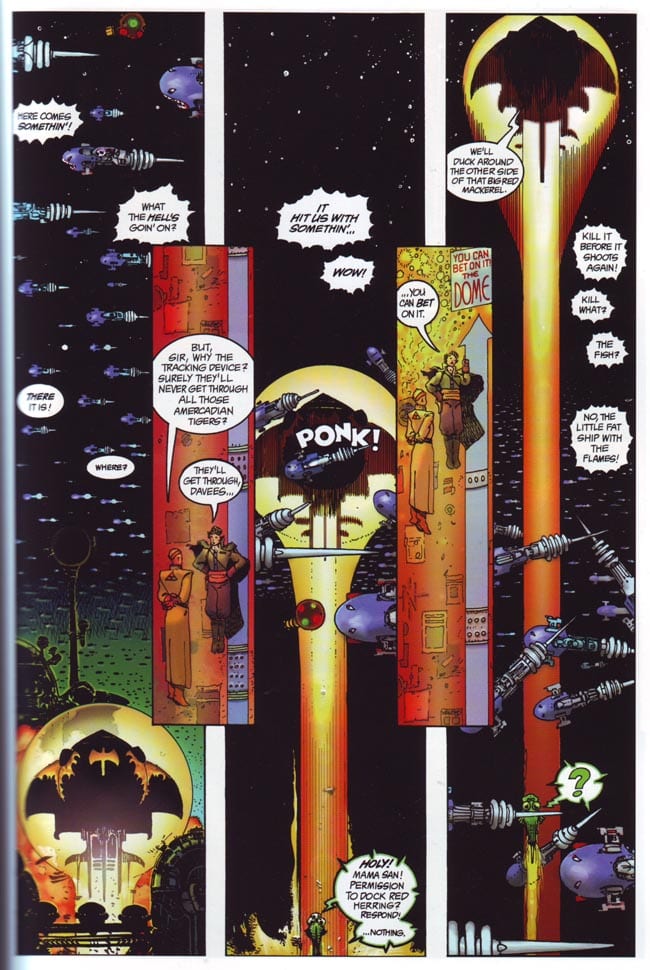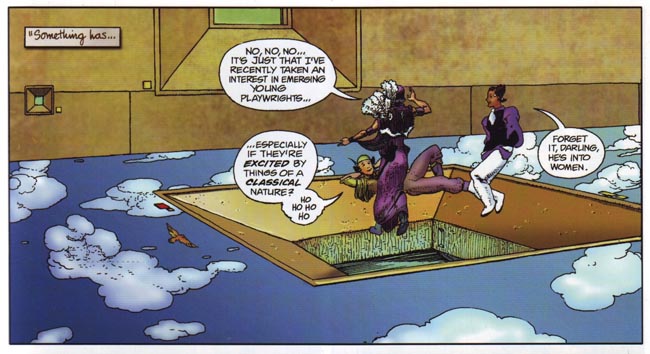Starstruck keeps re-starting and never finishing. And that’s okay. Maybe that’s the way we want it. Certainly it’s the way readers have been experiencing it for roughly 30 years. Starstruck has repeatedly gotten bigger and better without getting any farther, at least in traditional story terms of the end being farther than the beginning and the middle.
The seed of Starstruck was an off-Broadway play, likened to an episode of an ongoing science fiction television program in the introduction to this new hardcover edition from IDW. Since then, writer Elaine Lee and artist Michael Kaluta have been elaborating that nugget of a tale and sketch of a universe (backwards in time from the play’s events) into one of the grandest and strangest graphic enterprises in the comic book medium.
Partisans usually advocate for Starstruck by comparing it to some of the titles it immediately predates (Watchmen, The Dark Knight). Unfortunately, it doesn’t resemble them. Another approach has been to inventory “the interesting people and situations you will read about in this story.” And believe me, I understand the temptation to compare and to list; it’s very hard to look directly at Starstruck and say what it is.
So, for the purposes of this review, let us adopt the motto of Starstruck’s Galactic Girl Guides: “Truth as far as it goes.” That is to say, honesty is the best policy up to the point at which it isn’t, and then you just have to do what it takes to make the con come off properly. And the con here is to persuade you to pick up this book, because not having read it is sort of like not having read Pogo, or listened to Trout Mask Replica, or seen a Hayao Miyazaki film.
Truth as far as it goes: As a result of the ceaseless inventiveness of Lee and Kaluta and Lee Moyer’s new coloring, the imagined places and visual experience of Starstruck do share something with Miyazaki, most especially with Spirited Away and Howl’s Moving Castle – films that are themselves something like Winsor McCay Little Nemo visions set into motion by plots and characters of real substance. Starstruck is a candy store for the eye, a series of grand panoramas and lush Maxfield Parish tableaux, bright and deep and strange.
 Like Miyazaki, Starstruck’s creators are often working with recognizable, even archetypal, characters and plot elements, and like him, Lee and Kaluta so fully inhabit these characters and let them work out their own messy destinies that they defy and deform predictable genre arcs. In fact, it’s hard to tell what Starstruck’s arc might be, aside from certain stray clues that put a name to the eventual climax or possibly conclusion (“The Great Change”).
Like Miyazaki, Starstruck’s creators are often working with recognizable, even archetypal, characters and plot elements, and like him, Lee and Kaluta so fully inhabit these characters and let them work out their own messy destinies that they defy and deform predictable genre arcs. In fact, it’s hard to tell what Starstruck’s arc might be, aside from certain stray clues that put a name to the eventual climax or possibly conclusion (“The Great Change”).
Making our grasp of the plot and characters even more complicated, the story is being told retrospectively, from a point in the future that considers each piece of the tale to be a crucial turning point in a history that we’re already familiar with. Our implicit readerly position is that of a citizen of the galaxy that was transformed, decades ago, by the events being recounted. But we’re not that person. We’re the new kid in class, a transfer student from another galaxy, the only one hasn’t heard all of this 100 times, for whom the framework, the point, isn’t already ingrained. The other kids demand of the teacher, “Tell us again how Brucilla the Muscle met Galatia 9, who was really Mary Medea’s little sister, or maybe even her daughter.” We follow along as best we can.
Like The Watchmen, Starstruck is concerned with both the idea of inevitability in the unfolding of history (if we look at it backwards, nothing is chance) and the conspiratorial engineering of events by one or more individuals. But unlike Moore and Gibbons’ clockwork narrative machine, with its inexorable march toward a singular culmination and conclusion, Starstruck is not concerned with getting to the end. Things have been set into motion (were always already in motion), and Starstruck is the pinball machine of history in which these things, wobble, zing, rebound, and collide, clamorously and unpredictably. On its own terms, Starstruck cannot have an ending.
And yet the plot and the copious supplemental material gathered in the new book are consistent. Everything adds up, even if you cannot figure out what it might mean or where it’s headed. Starstruck’s reputation as a confusing book unfairly implies that it is a confused book, which it emphatically is not. History, culture, family relationships, religions, vernacular speech, and all manner of written texts from this fantastic world accumulate and intersect with perfect consistency. You can coordinate events by date. You can form hypotheses that are well supported and not contradicted, without being able to close the case.
And so you can become immersed in Starstruck in a different ways. You can sift for clues, move back and forth among pages, checking, verifying, assembling. Or you can simply give yourself over to it, and sink into each deeply imagined and beautifully rendered scene and character. Or you can do both, walking its pages first as a tourist and on second reading as a detective.
Truth as far as it goes: Perhaps one point of reference for Starstruck is Luigi Seraphini’s famously unknown and baffling tome, The Codex Serafinianus, which is a hypnotizing illustrated inventory of an imagined world, including extensive textual explanation in an invented language that nobody understands. As a codex, Seraphini’s work is in no way sequential or narrative; rather it is a series of isolated set pieces that give rise to a vast implication. Similarly, Starstruck is both a comic book story and a compendium of snapshots from another world.
This makes sense, coming from Kaluta, as he has spent more of his career working on stand alone illustrations and paintings than he has drawing sequential art. Indeed, most of his work has been outside comics, and most of his work within them has been for covers and splash pages. For this reason, his presence in comics seems greater than it is when measured by page count. He loomed especially large in the early Seventies, but even then his stories were relatively few: five issues of The Shadow, eight “Carson of Venus” backup stories in Korak, Son of Tarzan, and roughly a dozen stories in DC horror comics. This pattern of work has continued up to the present, with Starstruck remaining the gigantic exception.
Though the Kaluta style is unmistakable even in the early comics, it’s not entirely consistent, and it’s almost always inflected through a particular attitude toward the material. The Shadow’s illustration invoked Thirties pulps, while “Carson of Venus” featured a lighter, sketchier touch, with a slight echo of Frazetta’s and Alex Raymond’s work on similar material. The horror covers and splash pages overlap with Berni Wrightston’s early Seventies style and even Neal Adams. The spare lines and the frame breakdown of some Seventies sequences also resemble Walter Simonson’s “Manhunter” series. The earliest drawn pages of Starstruck (especially as originally printed) nod to Moebius and the Metal Hurlant style. (A gallery of Kaluta's Seventies DC work can be found on my blog here.)
This is not to say that Kaluta’s early work was derivative, but rather that he seems always to have approached his work as an illustrator, modulating his technique based on the material and the desired effect. His covers and splashes have always owed much to Czech Art Nouveau painter and decorative artist Alphonse Mucha (1860-1939), whose trademark composition combined a human figure with repetitious patterns and ornamental framing. The result is a dynamic balance, symmetrical up to a point. (Compare Mucha to Kaluta here and here.)
Echoes of this aesthetic are certainly evident in Starstruck, in the way pages are composed and in Kaluta’s approach to many individual panels. He is less interested in creating a page in which the action and eye tumble from left-to-right and top-to-bottom, than he is in capturing a series of discrete moments elegantly, or in asking the reader to slow down and contemplate the page as a whole, or spend a good long time inside a panoramic panel. Among other distinctions, Starstruck probably has more narrow panels that extend across the entire width of the page than any other comic book.
As important, there are no explanatory boxes of narrative copy to be found in Starstruck, urging you along, making everything obvious. Anything that’s not dialogue in a speech bubble is either raw data (time, place) or a quotation from a notable figure or book from within the Starstruck universe, casting a provocative or oblique light on events. Together, Lee and Kaluta have engineered a comic book storytelling mode that approaches documentary. No one is in a rush here. As a reader, it’s easy to be a spectator, to step inside and linger.
Interesting people and situations you will read about in this story:
Think of your favorite intergalactic saga. Now switch the sexes of all the characters, so Lieutenant Uhura and Prince Leia are the only guys. Now proceed with the action. In Starstruck, women are matriarchs and fighter pilots, ships’ captains and rebellion leaders, the makers of sexbots and the rebels without a cause, the religious leaders and the corporate vultures, the conniving and the hapless.
Now raise your hand if you read the preceding paragraph and imagined that Starstruck must be either a campy sci-fi gender parody or a didactic exploration of how things would be different if women were in charge of the galaxy. The fact that it is not remotely either of these things is one of writer Elaine Lee’s greatest accomplishments. She pulls off the coup, engineers the genre sex-change, without our even noticing. She realized that she didn’t need to do much more than change who got the close-up; instead of Luke Skywalker, it’s the pilot of the fighter off to his left, who actually turns out to be the important one. Lee’s characters have long been there in science fiction; she simply makes them the protagonists and extrapolates from there. Starstruck’s feminism is both as invisible and as pervasive as air, and therefore an accomplishment in its own right.
But this undershoots the mark as an account of the way Lee and Kaluta manipulate gender in Starstruck. A large percentage of the story’s pages are designed to inspire reader desire (mostly but not exclusively for the female body). And while Starstruck steers almost completely clear of confirming that sex has taken place anywhere, it also gives you the feeling that it might be happening everywhere, in any number of permutations. Polymorphous libido, too, is as pervasive as air in Starstruck, but like the story itself, it never reaches the climax that will kill it. Lee and Kaluta deserve a special award for appropriating the entire comic book tradition of women as eye candy for heterosexual male readers and setting those bodies free, throwing the reader’s desires and expectations for a loop.
Fact, for what it’s worth: Starstruck has had approximately three incarnations, which I’ll lay out in some detail, because they reveal not only a remarkable (perhaps unique) creative process but will also be important to anyone who becomes seriously interested in Starstruck:
1: 80 pages of discrete episodes are published in the magazines Ilustracion+Comix Internacional and Heavy Metal (1982). These pages are squarish in their proportions. The magazine stories are then published together as an early “graphic novel” by Marvel’s Epic imprint (1984).
2. The whole story starts over again, from the same first page of the first magazine story, but in black and white, in a new Dark Horse series that runs for four thick issues (1990). This edition only gets as far as the first issue of the earlier Epic six-issue series. However, Kaluta and Lee add an astounding 100 new pages to this portion of the story. Appropriately, they call it Starstruck: The Expanding Universe.
3. Beginning in 2009, IDW reprints the Kitchen Sink Dark Horse version of Starstruck in 13 issues, colored by Lee Moyer. But wait: Even though the story gets no farther this time than the last time, it gets bigger again. In order to make the first 80 pages (of squarish proportions) match all the rest of the pages, Kaluta expands each one, revising existing panels and adding new ones.
The IDW series is what you get in the deluxe hardcover being reviewed here, which adds many pages of related back-up stories (some reprints, some new) and a dense collection of supporting material created by Elaine Lee (some reprinted, some new) to help coordinate and illuminate the Starstruck universe.
You won’t find the material from issues #2-6 of the Epic series in this book, but Lee and Kaluta hope to expand that part of the story too and then forge ahead beyond it. Don’t hold your breath; it’s taken them 30 years to finish the first third of the story. More importantly, it’s a legitimate question whether Starstruck is in fact currently incomplete or whether it can be completed or whether it should be. Do we want this universe to expand to the point where it then begins to collapse in on itself, all questions answered, all connections formed, all arcs complete? I’m not sure I do. The time to get on board is now, with this book, which is the truth as far as it needs to go.









